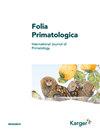Sahamalaza Sportive Lemur, Lepilemur sahamalaza, Vocal Communication: Call Use, Context and Gradation
IF 1.2
4区 生物学
Q2 ZOOLOGY
引用次数: 8
Abstract
Stereotypical vocalisations can facilitate long-distance communication in dense and, thus, sound-degrading forest habitats. Despite this, primate vocal repertoires often also include gradations between different call types that are used in social interactions. Because many nocturnal primates show a solitary social structure, it has been difficult to assess the role vocalisations play in mediating their social encounters. Here we aim to expand on the call types of Sahamalaza sportive lemurs, Lepilemur sahamalaza, as well as investigate their variability and use in social contexts. Through long-term behavioural observations with concurrent recording of vocalisations of known and unknown individuals between 2015 and 2016, we described three previously unrecorded calls and expanded the vocal repertoire to 12 different call types that were used in both targeted social and broadcast solitary contexts. Linear discriminant function and cluster analysis supported initial observations that vocalisations within call types were variable and that at least two call types can be classified as “graded,” contrary to expectations. Despite variations in call-context connections, no clear patterns of call use could be established. However, measurable differences in vocal behaviour between the seasons and the sexes indicate that calling is used in a reproductive context, similar to other nocturnal and diurnal primates.Sahamalaza Sportive Lemur,Lepilemur Sahamalaza,声乐交流:呼叫使用、上下文和分级
刻板的发声可以促进在茂密的森林栖息地进行远距离交流,从而降低声音。尽管如此,灵长类动物的声乐曲目通常也包括社交互动中使用的不同叫声类型之间的分级。由于许多夜间活动的灵长类动物表现出孤独的社会结构,因此很难评估发声在调节它们的社会遭遇中所起的作用。在这里,我们的目标是扩展撒哈拉运动狐猴Lepilemur Sahamalaza的叫声类型,并调查它们在社会环境中的变异性和使用情况。通过长期的行为观察,同时记录2015年至2016年间已知和未知个体的发声,我们描述了三个以前未记录的叫声,并将声乐曲目扩展到12种不同的叫声类型,这些叫声类型用于有针对性的社交和广播孤立环境。线性判别函数和聚类分析支持了最初的观察结果,即呼叫类型中的发声是可变的,至少有两种呼叫类型可以被归类为“分级”,这与预期相反。尽管呼叫上下文连接各不相同,但无法建立明确的呼叫使用模式。然而,季节和性别之间声音行为的可测量差异表明,叫声是在生殖环境中使用的,类似于其他夜间和日间灵长类动物。
本文章由计算机程序翻译,如有差异,请以英文原文为准。
求助全文
约1分钟内获得全文
求助全文
来源期刊

Folia Primatologica
生物-动物学
CiteScore
3.30
自引率
10.50%
发文量
36
审稿时长
>12 weeks
期刊介绍:
Recognizing that research in human biology must be founded on a comparative knowledge of our closest relatives, this journal is the natural scientist''s ideal means of access to the best of current primate research. ''Folia Primatologica'' covers fields as diverse as molecular biology and social behaviour, and features articles on ecology, conservation, palaeontology, systematics and functional anatomy. In-depth articles and invited reviews are contributed by the world’s leading primatologists. In addition, special issues provide rapid peer-reviewed publication of conference proceedings. ''Folia Primatologica'' is one of the top-rated primatology publications and is acknowledged worldwide as a high-impact core journal for primatologists, zoologists and anthropologists.
 求助内容:
求助内容: 应助结果提醒方式:
应助结果提醒方式:


